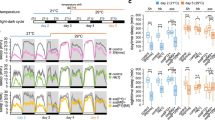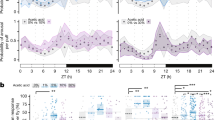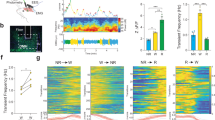Abstract
Many lines of evidence indicate that GABA and GABAA receptors make important contributions to human sleep regulation. Pharmacological manipulation of these receptors has differential effects on sleep onset and sleep maintenance insomnia. Here we show that sleep is regulated by GABA in Drosophila and that a mutant GABAA receptor, RdlA302S, specifically decreases sleep latency. The drug carbamazepine (CBZ) has the opposite effect on sleep; it increases sleep latency as well as decreasing sleep. Behavioral and physiological experiments indicated that RdlA302S mutant flies are resistant to the effects of CBZ on sleep latency and that mutant RDLA302S channels are resistant to the effects of CBZ on desensitization, respectively. These results suggest that this biophysical property of the channel, specifically channel desensitization, underlies the regulation of sleep latency in flies. These experiments uncouple the regulation of sleep latency from that of sleep duration and suggest that the kinetics of GABAA receptor signaling dictate sleep latency.
This is a preview of subscription content, access via your institution
Access options
Subscribe to this journal
Receive 12 print issues and online access
$209.00 per year
only $17.42 per issue
Buy this article
- Purchase on Springer Link
- Instant access to full article PDF
Prices may be subject to local taxes which are calculated during checkout






Similar content being viewed by others
References
Roth, T. Prevalence, associated risks, and treatment patterns of insomnia. J. Clin. Psychiatry 66 Suppl 9, 10–13 quiz 42–43 (2005).
Rosenberg, R.P. Sleep maintenance insomnia: strengths and weaknesses of current pharmacologic therapies. Ann. Clin. Psychiatry 18, 49–56 (2006).
Holbrook, A.M., Crowther, R., Lotter, A., Cheng, C. & King, D. Meta-analysis of benzodiazepine use in the treatment of insomnia. CMAJ 162, 225–233 (2000).
Smith, G.B. & Olsen, R.W. Functional domains of GABAA receptors. Trends Pharmacol. Sci. 16, 162–168 (1995).
Hevers, W. & Luddens, H. The diversity of GABAA receptors. Pharmacological and electrophysiological properties of GABAA channel subtypes. Mol. Neurobiol. 18, 35–86 (1998).
Gottesmann, C. GABA mechanisms and sleep. Neuroscience 111, 231–239 (2002).
Lancel, M. Role of GABAA receptors in the regulation of sleep: initial sleep responses to peripherally administered modulators and agonists. Sleep 22, 33–42 (1999).
Greenspan, R.J. & Dierick, H.A. 'Am not I a fly like thee?' From genes in fruit flies to behavior in humans. Hum. Mol. Genet. 13 Spec No 2, R267–273 (2004).
Hendricks, J.C., Sehgal, A. & Pack, A.I. The need for a simple animal model to understand sleep. Prog. Neurobiol. 61, 339–351 (2000).
Nitz, D.A., van Swinderen, B., Tononi, G. & Greenspan, R.J. Electrophysiological correlates of rest and activity in Drosophila melanogaster. Curr. Biol. 12, 1934–1940 (2002).
van Swinderen, B., Nitz, D.A. & Greenspan, R.J. Uncoupling of brain activity from movement defines arousal states in Drosophila. Curr. Biol. 14, 81–87 (2004).
Shaw, P.J., Cirelli, C., Greenspan, R.J. & Tononi, G. Correlates of sleep and waking in Drosophila melanogaster. Science 287, 1834–1837 (2000).
Hendricks, J.C. et al. Rest in Drosophila is a sleep-like state. Neuron 25, 129–138 (2000).
Bushey, D., Huber, R., Tononi, G. & Cirelli, C. Drosophila Hyperkinetic mutants have reduced sleep and impaired memory. J. Neurosci. 27, 5384–5393 (2007).
Cirelli, C. et al. Reduced sleep in Drosophila Shaker mutants. Nature 434, 1087–1092 (2005).
Joiner, W.J., Crocker, A., White, B.H. & Sehgal, A. Sleep in Drosophila is regulated by adult mushroom bodies. Nature 441, 757–760 (2006).
Pitman, J.L., McGill, J.J., Keegan, K.P. & Allada, R. A dynamic role for the mushroom bodies in promoting sleep in Drosophila. Nature 441, 753–756 (2006).
Ganguly-Fitzgerald, I., Donlea, J. & Shaw, P.J. Waking experience affects sleep need in Drosophila. Science 313, 1775–1781 (2006).
Stilwell, G.E., Rocheleau, T. & Ffrench-Constant, R.H. GABA receptor minigene rescues insecticide resistance phenotypes in Drosophila. J. Mol. Biol. 253, 223–227 (1995).
Ffrench-Constant, R.H., Rocheleau, T.A., Steichen, J.C. & Chalmers, A.E. A point mutation in a Drosophila GABA receptor confers insecticide resistance. Nature 363, 449–451 (1993).
Lee, D., Su, H. & O'Dowd, D.K. GABA receptors containing Rdl subunits mediate fast inhibitory synaptic transmission in Drosophila neurons. J. Neurosci. 23, 4625–4634 (2003).
Aronstein, K., Auld, V. & Ffrench-Constant, R. Distribution of two GABA receptor–like subunits in the Drosophila CNS. Invert. Neurosci. 2, 115–120 (1996).
Zhang, H.G., Ffrench-Constant, R.H. & Jackson, M.B. A unique amino acid of the Drosophila GABA receptor with influence on drug sensitivity by two mechanisms. J. Physiol. (Lond.) 479, 65–75 (1994).
Brand, A.H. & Dormand, E.L. The GAL4 system as a tool for unraveling the mysteries of the Drosophila nervous system. Curr. Opin. Neurobiol. 5, 572–578 (1995).
Hodge, J.J., Choi, J.C., O'Kane, C.J. & Griffith, L.C. Shaw potassium channel genes in Drosophila. J. Neurobiol. 63, 235–254 (2005).
Ffrench-Constant, R.H., Mortlock, D.P., Shaffer, C.D., MacIntyre, R.J. & Roush, R.T. Molecular cloning and transformation of cyclodiene resistance in Drosophila: an invertebrate gamma-aminobutyric acid subtype A receptor locus. Proc. Natl. Acad. Sci. USA 88, 7209–7213 (1991).
Ambrosio, A.F., Soares-Da-Silva, P., Carvalho, C.M. & Carvalho, A.P. Mechanisms of action of carbamazepine and its derivatives, oxcarbazepine, BIA 2–093, and BIA 2–024. Neurochem. Res. 27, 121–130 (2002).
Granger, P. et al. Modulation of the gamma-aminobutyric acid type A receptor by the antiepileptic drugs carbamazepine and phenytoin. Mol. Pharmacol. 47, 1189–1196 (1995).
Spina, E. & Perugi, G. Antiepileptic drugs: indications other than epilepsy. Epileptic Disord. 6, 57–75 (2004).
Bazil, C.W. Effects of antiepileptic drugs on sleep structure: are all drugs equal? CNS Drugs 17, 719–728 (2003).
Buhr, A. et al. Functional characterization of the new human GABA(A) receptor mutation beta3(R192H). Hum. Genet. 111, 154–160 (2002).
Greenleaf, A.L., Borsett, L.M., Jiamachello, P.F. & Coulter, D.E. α-amanitin–resistant D. melanogaster with an altered RNA polymerase II. Cell 18, 613–622 (1979).
Aronstein, K., Ode, P. & Ffrench-Constant, R. Direct comparison of PCR-based monitoring for cyclodiene resistance in Drosophila populations with insecticide bioassay. Pestic. Biochem. Physiol. 48, 229–233 (1994).
Andretic, R. & Shaw, P.J. Essentials of sleep recordings in Drosophila: moving beyond sleep time. Methods Enzymol. 393, 759–772 (2005).
Boileau, A.J., Baur, R., Sharkey, L.M., Sigel, E. & Czajkowski, C. The relative amount of cRNA coding for gamma2 subunits affects stimulation by benzodiazepines in GABA(A) receptors expressed in Xenopus oocytes. Neuropharmacology 43, 695–700 (2002).
Priestley, C.M., Williamson, E.M., Wafford, K.A. & Sattelle, D.B. Thymol, a constituent of thyme essential oil, is a positive allosteric modulator of human GABA(A) receptors and a homo-oligomeric GABA receptor from Drosophila melanogaster. Br. J. Pharmacol. 140, 1363–1372 (2003).
Brewster, M.E., Anderson, W.R., Estes, K.S. & Bodor, N. Development of aqueous parenteral formulations for carbamazepine through the use of modified cyclodextrins. J. Pharm. Sci. 80, 380–383 (1991).
Masson, M., Sigurdardottir, B.V., Matthiasson, K. & Loftsson, T. Investigation of drug-cyclodextrin complexes by a phase-distribution method: some theoretical and practical considerations. Chem. Pharm. Bull. (Tokyo) 53, 958–964 (2005).
Acknowledgements
We are grateful to E. Marder, R. Allada and R. Greenspan for comments on the manuscript. This work was funded by a grant from the US Army (W81XWH-04-1-0158) to M.R. and L.C.G., and MH 067284 to L.C.G.
Author information
Authors and Affiliations
Corresponding author
Supplementary information
Supplementary Text and Figures
Supplementary Figures 1 (PDF 771 kb)
Rights and permissions
About this article
Cite this article
Agosto, J., Choi, J., Parisky, K. et al. Modulation of GABAA receptor desensitization uncouples sleep onset and maintenance in Drosophila. Nat Neurosci 11, 354–359 (2008). https://doi.org/10.1038/nn2046
Received:
Accepted:
Published:
Issue Date:
DOI: https://doi.org/10.1038/nn2046
This article is cited by
-
Genome-wide association in Drosophila identifies a role for Piezo and Proc-R in sleep latency
Scientific Reports (2024)
-
Peculiar sleep features in sympatric species may contribute to the temporal segregation
Journal of Comparative Physiology B (2023)
-
The Role of the Dopamine Transporter in the Effects of Amphetamine on Sleep and Sleep Architecture in Drosophila
Neurochemical Research (2022)
-
The Effect of Sleep Deprivation and Subsequent Recovery Period on the Synaptic Proteome of Rat Cerebral Cortex
Molecular Neurobiology (2022)
-
Compartment specific regulation of sleep by mushroom body requires GABA and dopaminergic signaling
Scientific Reports (2021)



